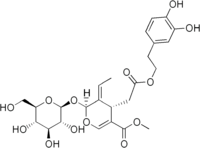Oleuropein
 | |
| Names | |
|---|---|
| IUPAC name
(4S,5E,6S)-4-[2-[2-(3,4-dihydroxyphenyl)ethoxy]-2-oxoethyl]- 5-ethylidene-6-[[(2S,3R,4S,5S,6R)-3,4,5-trihydroxy-6-(hydroxymethyl)-
2-tetrahydropyranyl]oxy]-4H-pyran-3-carboxylic acid, methyl ester | |
| Identifiers | |
| 32619-42-4 | |
| ChEMBL | ChEMBL1911053 |
| ChemSpider | 4444876 |
| |
| Jmol-3D images | Image |
| PubChem | 5281544 |
| |
| Properties | |
| C25H32O13 | |
| Molar mass | 540.51 g/mol |
| Except where noted otherwise, data is given for materials in their standard state (at 25 °C (77 °F), 100 kPa) | |
| | |
| Infobox references | |
Oleuropein is a phenylethanoid, a type of phenolic compound found in olive leaf together with other closely related compounds such as 10-hydroxyoleuropein, ligustroside, and 10-hydroxyligustroside. All these compounds are tyrosol esters of elenolic acid that are further hydroxylated and glycosylated. It is one of the main natural phenols found in argan oil.[1] It is also found in the leaves of privet.
Oleuropein and its metabolite hydroxytyrosol display antioxidant activity in vitro and contribute bitter taste to olive oil. Although oleuropein preparations have been claimed to have pharmacological effects,[2][3] none of these has been demonstrated in humans.
Oleuropein is traditionally removed from olives due to its bitterness.
See also
- Hydroxytyrosol
- Oleocanthal
- Olive Leaf
References
- ↑ Phenols and Polyphenols from Argania spinosa. Z. Charrouf and D. Guillaume, American Journal of Food Technology, 2007, 2, pages 679-683, doi:10.3923/ajft.2007.679.683
- ↑ Haris Omar, Syed (2010). "Oleuropein in Olive and its Pharmacological Effects". Scientia Pharmaceutica 78 (2): 133–54. doi:10.3797/scipharm.0912-18. PMC 3002804. PMID 21179340.
- ↑ Sudjana, Aurelia N.; D’Orazio, Carla; Ryan, Vanessa; Rasool, Nooshin; Ng, Justin; Islam, Nabilah; Riley, Thomas V.; Hammer, Katherine A. (2009). "Antimicrobial activity of commercial Olea europaea (olive) leaf extract". International Journal of Antimicrobial Agents 33 (5): 461–3. doi:10.1016/j.ijantimicag.2008.10.026. PMID 19135874.
Further reading
- Barbaro, Barbara; Toietta, Gabriele; Maggio, Roberta; Arciello, Mario; Tarocchi, Mirko; Galli, Andrea; Balsano, Clara (2014). "Effects of the olive-derived polyphenol oleuropein on human health". International Journal of Molecular Sciences 15 (10): 18508–18524. doi:10.3390/ijms151018508. PMID 25318054.
- Tripoli, Elisa; Giammanco, Marco; Tabacchi, Garden; Di Majo, Danila; Giammanco, Santo; La Guardia, Maurizio (2009). "The phenolic compounds of olive oil: Structure, biological activity and beneficial effects on human health". Nutrition Research Reviews 18 (1): 98–112. doi:10.1079/NRR200495. PMID 19079898.
- Walter Jr, WM; Fleming, HP; Etchells, JL (1973). "Preparation of antimicrobial compounds by hydrolysis of oleuropein from green olives". Applied microbiology 26 (5): 773–6. PMC 379900. PMID 4762396.
- Andreadou, Ioanna; Iliodromitis, Efstathios K.; Mikros, Emmanuel; Constantinou, Maria; Agalias, Apostolos; Magiatis, Prokopios; Skaltsounis, Alexios Leandros; Kamber, Elli et al. (2006). "The Olive Constituent Oleuropein Exhibits Anti-Ischemic, Antioxidative, and Hypolipidemic Effects in Anesthetized Rabbits". The Journal of Nutrition 136 (8): 2213–9. PMID 16857843.
- Leehuang, S; Huang, P; Zhang, D; Lee, J; Bao, J; Sun, Y; Chang, Y; Zhang, J; Huang, P (2007). "Discovery of small-molecule HIV-1 fusion and integrase inhibitors oleuropein and hydroxytyrosol: Part I. Integrase inhibition". Biochemical and Biophysical Research Communications 354 (4): 872–8. doi:10.1016/j.bbrc.2007.01.071. PMC 2790717. PMID 17275783.
- Lee-Huang S, Huang P, Huang P (July 11–16, 2004). "Anti-HIV activity of olive leaf extract and synergism with HAART". Int Conf AIDS 15th. Bangkok.
| ||||||||||||||